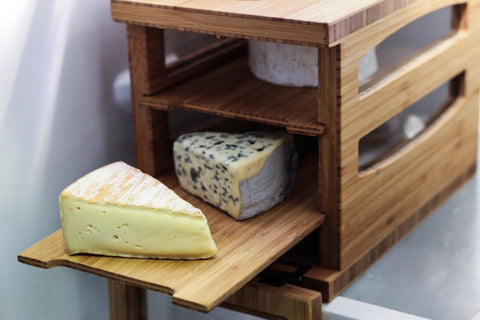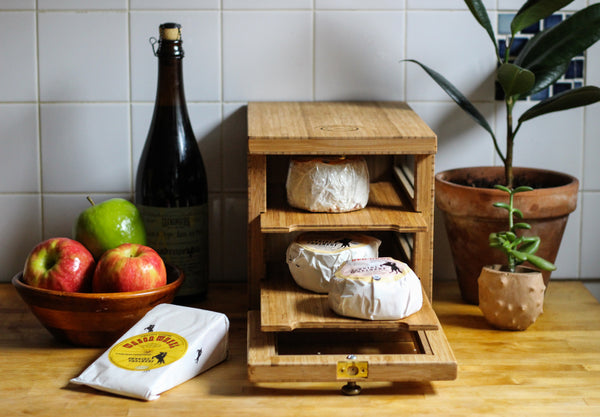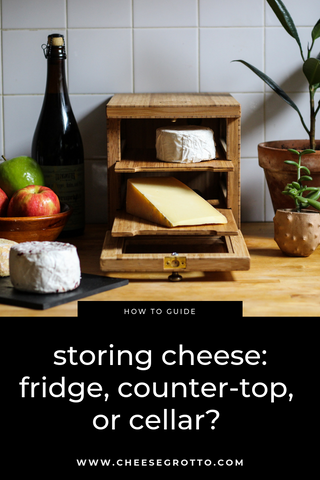So you’ve done something nice for yourself—and all your favorite cheeses—by picking up a Cheese Grotto.
You love the elegance and warmth of its design and natural wood construction, and you really love how it keeps your cheeses fresh without the ongoing expense and non-recyclable waste of cheese paper. You enjoy its rusticity, a throwback to the days before refrigeration when cheese caves really were caves, because of the constant humidity and cool, consistent temperatures they offered.
These days, we have a few more options for how we store cheese than our caseophile forebears. Here are some of the different places you can keep your Cheese Grotto to get the most out of the best cheese storage available.
In the Refrigerator

As great as it is for storing food overall, the refrigerator can be an inhospitable climate for cheese. Because of its constantly blowing air, it can dry cheese out in less than a day. The Grotto protects against this by providing a humid, breathable environment within your refrigerator’s cold, shelf life-extending climate.
The Grotto outperforms other storage methods like cheese paper, plastic wrap, and reusable wax wraps when kept in the fridge. With temperatures typically between 35°F and 40°F, it extends the shelf life and quality of each wedge and wheel up to 3 to 6 weeks, with no external fluctuations of temperature and humidity that can affect the quality of your cheese.
This is a foolproof method for Grotto storage, perfect for budding connoisseurs. When you’re craving a cheese board, just pull the whole Grotto or Grotto serving tray out of your fridge at least an hour before you want to eat so your cheeses can come up to serving temperature.
Ready to level up? Try storing your Cheese Grotto...
On the Counter

What if your cheese was always at the perfect temperature? What if, instead of taking it out of the fridge to relax before enjoying, you could dig in at a moment’s notice?
In France, people leave their cheeses out all day, usually on a wooden board covered with a breathable cloth. Top cheese specialists like chef Steven Jenkins, Saxelby Cheese owner Anne Saxelby, and cheesemaker Matt Spiegler also store their Cheese Grotto on the counter. That’s because they understand how climate affects fine cheese and know that it develops more complex flavors as it ripens in temperatures warmer than the refrigerator.
If your kitchen or dining room stays consistently below 70°F, consider storing your Grotto on the counter. That way, each wheel and wedge will always taste lively, with the rich aromas and supple textures you love in your favorite varieties. Soft-ripened cheeses, washed rinds, blues, hard cheeses—they’re all delicious when stored at room temperature in the Grotto.
If your space is consistently above 70°F, you might want to store your Cheese Grotto in...
The Cellar
A consistently cool cellar or finished basement is the perfect middle ground between fridge and countertop. If you have a space like this in your home, you’ve got the perfect place to store your Grotto.
If you have a wine cellar whose temperature can be monitored and adjusted easily, that’s even better. Wine cellars and wine fridges are typically kept slightly warmer than a refrigerator, between 45°F and 55oF. Since cheese caves are typically between 45°F and 55°F, a wine cellar is ideal for cheese storage.
With a cool-but-not-cold space like this—and a contained, humidity-controlled environment like the Cheese Grotto—you’ve got the perfect conditions to try aging whole wheels of cheese at home. This method takes a bit more attention and knowhow than storing the Grotto in the fridge, but can provide wonderful results.
Store young, uncut wheels of Brie or Camembert in the Grotto and age them to your preferred ripeness. You can also make your own small-batch cheese at home and age it from start to finish in your Grotto this way.
How are you using your Cheese Grotto to get creative with storing cheese? Let us know!
Different Styles of Cheese
To learn more about different cheese's characteristics and their preferred preservation methods, you can read Part 1 of an endless series on cheese preservation tips.



Leave a comment